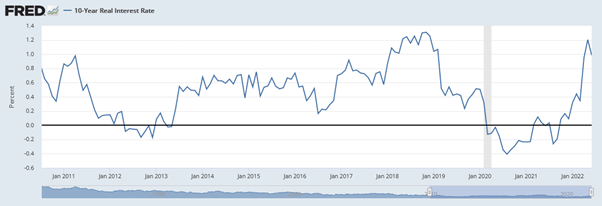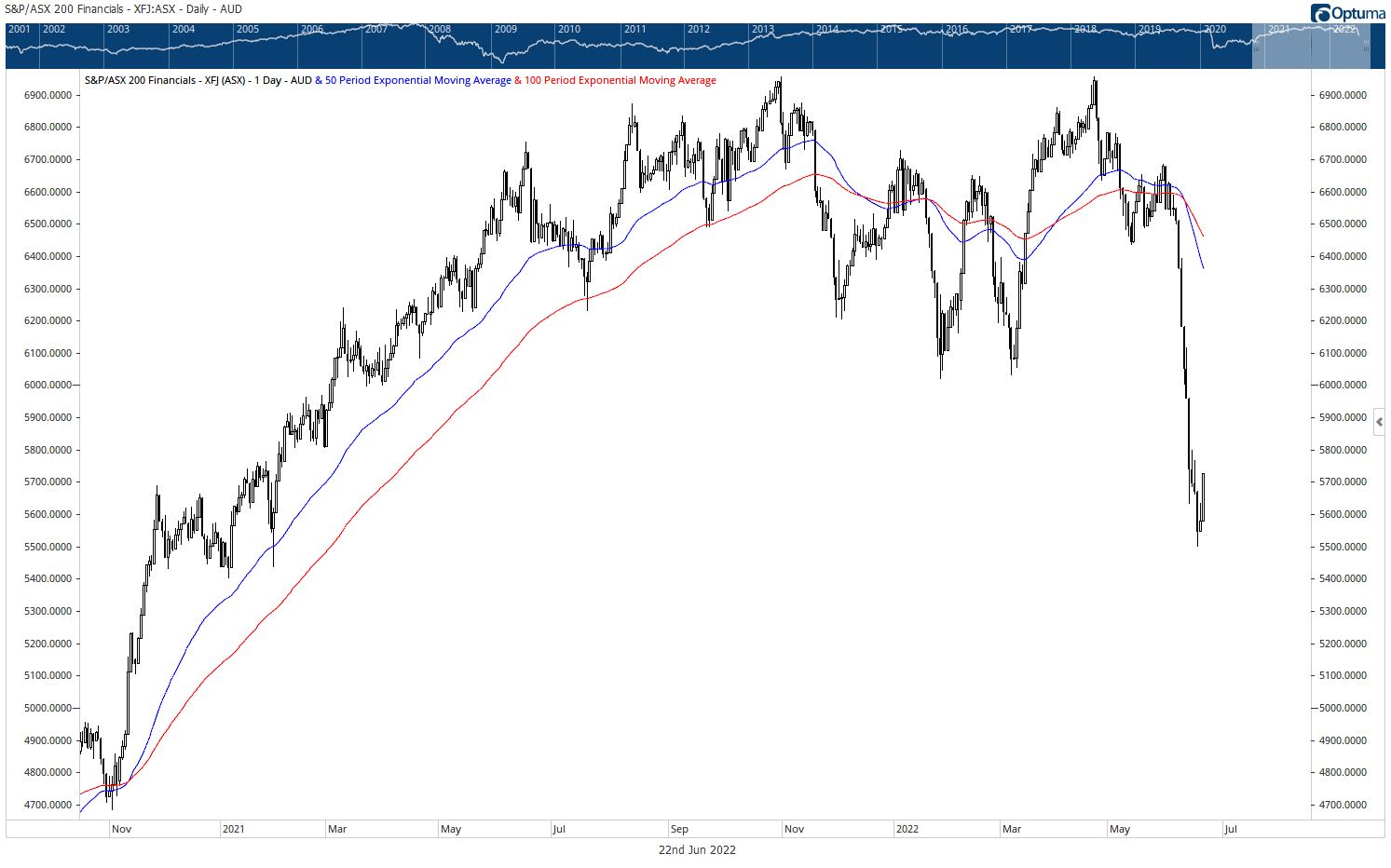Why inflation is a rearview mirror story
I read with interest the ‘Livewire readers’ 20 most tipped stocks to beat inflation’ article earlier this week.
Mainly because I’ve spent the past few months positioning members of my advisory service in companies that I think will benefit when inflation recedes in the back half of 2022.
In other words, I’m on the other side of the inflation trade here.
To me, the inflation trade is yesterday’s story. The market looks ahead, and it’s telling anyone who wants to listen that inflationary pressures have peaked.
The readers’ top hedge against inflation is BHP(ASX: BHP). That makes sense. It’s a commodity producer. Commodities go up during inflation. Except that’s not what is happening.
BHP’s major earner, iron ore, is down around 30% from its March high and nearly 50% from its May 2021 peak.
Copper is breaking down and is now at its lowest price since February 2021. It’s nearly 25% off its high (after plunging 5% overnight).
Met coal prices are strong but the Queensland government wants a bigger cut through higher royalty prices.
BHP will still make good profits with commodities at these prices. But the trend has turned for the commodity complex.
Take a look at energy. For so long it was the only sector doing well in this bear market. But tighter monetary conditions are starting to bite. Oil and energy are beginning to correct lower.
The West Texas Intermediate (WTI) price is now around US$104 a barrel, down from the US$130 peak reached in early March.
Global oil companies are down sharply in the past few weeks. The chart below shows the BetaShares Global Energy Companies ETF (ASX:FUEL). It’s corrected 20% from the peak.
I initially recommended this ETF back in 2021 and sold in April around $6. I’ll be looking to buy back in in the months ahead as this energy correction continues.
![BetaShares Global Energy Companies ETF [ASX:FUEL] Source: Optuma](https://www.livewiremarkets.com/rails/active_storage/blobs/proxy/eyJfcmFpbHMiOnsibWVzc2FnZSI6IkJBaHBBdy8vQVE9PSIsImV4cCI6bnVsbCwicHVyIjoiYmxvYl9pZCJ9fQ==--66b605f8bbc517af7ab51c86b644d185b5a968fe/FUEL.png)
But for now, higher interest rates are leading to demand destruction in global energy markets. That means Woodside (ASX: WDS) (which came in at number four on the inflation hedge list) might not be the best trade over the next six months.
To be clear, I am long-term bullish on Woodside and energy in general. I just think central bankers’ determination to contain inflation will crush demand and energy will suffer in the shorter term.
The bottom line is that inflation is a rearview mirror story.
Having helped cause this inflationary breakout (by funding deficit spending that paid people to stay home, consume and not produce), central bankers are now determined to end it.
They have gone from erring on the side of caution (in the post 2008 QE era) to now erring on the side of doing too much.
I mean, consider the comments this week from Fed Chairman Powell, from The Wall Street Journal:
‘Federal Reserve Chairman Jerome Powell said the central bank’s battle against inflation could lead it to raise interest rates high enough to cause a recession, offering his most explicit warning this year.
‘“It’s not our intended outcome at all, but it’s certainly a possibility,” Mr. Powell said Wednesday during the first of two days of congressional hearings. “We are not trying to provoke and do not think we will need to provoke a recession, but we do think it’s absolutely essential” to bring down inflation, which is running at a 40-year high.’
This change in rhetoric and attitude is bad for asset prices. Because to get on top of inflation, you need to increase real rates. Asset prices generally don’t like rising real rates. And as you can see in the chart below, US real 10-year rates have increased markedly in the past 12 months.
The last time US real rates were at this level was in 2018. That was during the last tightening cycle. The difference was that the US and global economy were in an expansion phase and inflation wasn’t an issue.
Real rates were rising because growth was strong.

But they reached a point in late 2018 where it caused the S&P 500 to crash and the economy to slow. The highly indebted economy couldn’t handle real rates of around 1.3%. So the Fed changed course. It ended QT, put interest rate rises on hold, and started to ease again soon after. This was the Powell Pivot.
The same thing is happening now. That is, sharply higher real rates are causing an economic slowdown (which will more than likely lead to a recession in the US by the end of the year) and a tanking S&P 500. Except Powell can’t pivot yet because inflation is still too high, and he needs tighter financial conditions to crush demand and get inflation under control.
That’s why stocks are falling and will continue to fall.
Aussie stocks caught up with this way of thinking last week. It dawned on the market that the RBA would need to raise rates considerably to get on top of inflation.
I mean, have a look at the ASX 200 Financials Index:

It’s fallen off a cliff. And it’s directly related to this perceived change of mood from central bankers.
I looked through the charts of all the stocks in the ASX 200 this week. The number of individual stocks that look like the above is incredible. And if they don’t, it’s because they have already fallen hard.
There are very, very few that look healthy from a charting perspective.
But that’s what bear markets do. Asset prices go from being overvalued to undervalued. The good news is that I think we’re well into that process. From top to bottom, the ASX 200 has declined around 16% so far.
For comparison, the 2015 bear market saw the index lose 21%. From the 2010 high to the 2011 low, stocks fell around 23%. The credit crisis resulted in a much bigger, 50% decline. And the dotcom bust period in the early 2000s also saw stocks fall around 23%.
So we’re getting close to those 20% plus figures. The credit crisis was an obvious outlier. Australia boomed into the 2007 high. This time around, its post-COVID rally was weak compared to US stocks, especially tech stocks.
So not having gone up as much, we’re unlikely to fall as far during the tightening cycle.
Which begs the question, just how much further have we got to go?
The two-year bond yield is a good proxy for where the market thinks the Fed funds rate is going. It’s currently trading around 3%, down from a peak of 3.4% just two weeks ago. That suggests there is only another 100-125 basis points of tightening in store.
The US Fed has its next meeting in late July. It will potentially hike another 75 basis points. So that’s a good chunk of the total right there. It takes a break in August and then meets again in September. Will it hike by 50 basis points and be done?
And don’t forget, quantitative tightening ratchets up at the start of September, with the Fed shrinking its balance sheet by US$95 billion per month, double the current amount. This represents an additional draining of liquidity from financial markets.
With this in mind, by the time the Fed meets again on 20–21 September, things might be a little different to what they are now.
That is, we might not be so worried about inflation as we are about recession and deflation.
So taking the other side of the inflation trade, I would consider investments like bond ETFs, property trusts, high yield infrastructure plays that have been hurt by rising bond yields, and gold stocks.
The perceived risk of these investment ideas is quite high in an environment where everyone is focused on inflation. But in my view, the actual risks, where much bad news is already priced in, is much lower.
2 topics
3 stocks mentioned

